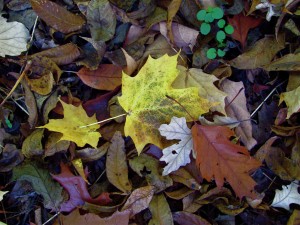Everybody thinks sustainability costs more money, but here’s a little tip that won’t cost you a dime and in fact could save you a lot of money. Imagine taking your leaves to the dump, paying them to take the leaves, and then paying more money to get more compost. We do it all the time because we thought it was the only option (well, my grandpa didn’t).

Why use mulch in the first place?
Putting down compost or other mulch is really the best way to protect your landscape from weed invasion, soil particulation (where raindrops break large pieces of soil down into smaller and smaller pieces that create a hard crust on the top of your soil making it nearly impossible for air to enter the soil) and come the summer months, water evaporation. When weeds do come up, a good 2 inch layer of mulch makes them really easy to pull. All of that makes buying mulch well worth it.
Return on investment you say?
But what if we didn’t have to even buy mulch? What if we didn’t even have to take it to the dump in the first place? The last several years, DeSantis Landscapes has been mulching leaves on our clients’ properties directly onto their beds. When the leaves fall, we use an impeller vacuum machine to suck the leaves up into a large truck and in the process the leaves are ground down into smaller pieces. The next step is simple, we blow the broken down leaves back onto our clients’ beds. Voilà, free mulch! That’s what we call an infinite return on investment! Some of our clients have saved thousands of dollars using this technique.

As is always the case, everything has a pro and con. For example, if you are an HOA and your homeowners are not familiar with the look, you could get some complaints. We anticipated that to be the case at some of our sites. However, it turns out we really didn’t see any complaints at all. If you do anticipate complaints, at least you can cut your mulch bill in half. Instead of applying 2 inches of mulch per year, apply 1 inch of free leaf mulch and top dress it with 1 inch of purchased compost or Hemlock. You’ll receive the same benefit but visually no one will be the wiser.
Are leaves as good as compost?
The real answer is “they are different.” Compost provides a vast number of nutrients and some micro-organisms to the soil. As well, it improves soil tilth by adding organic matter. However in the process of creating compost nearly 50% of the nutrients in the fresh material is gone by the time the finished compost is ready to use (the microbial action that makes compost what it is, requires that much food to function). This is not the case with fresh leaves. All of the nutrient are still in there, and plants can use them.
If we open the cell structure of the leaves up to microbes, the microbes will make the much needed micronutrients; calcium, magnesium, potassium and phosphorus, available in the soil. There is a qualification here. Freshly fallen leaves have higher percentage of nutrients (namely more nitrogen) available but because we are not adding nitrogen (e.g. green grass clippings) and because a 2” leaf layer is not nearly as dense as a 2” compost, the total lbs of nutrients available will be less. But it’s free! And it can last longer.
A common concern we get about compost is that it doesn’t last very long. This is especially the case when the soil is thirsty for nutrients. Fresh leaf mulch breaks down more slowly than compost and feeds plants over a longer period of time. That also means you get the benefits of weed suppression, soil protection, and water conservation for a longer period of time.
Some other great tidbits about using leaves:
- Leaf mold can hold up to 500% of its weight in water.
- Remember to keep your trees healthy so you don’t have to worry about spreading disease like anthracnose.
- Not all leaves are great for composting and among those that are – not all are created equal.
- Pound for pound, the leaves of most tress contain twice the mineral content of manure.*
- The McGraw-Hill Recycling Handbook, Second Edition states that overall leaves make up 25 percent of all yard wastes in the U.S.
Eight million tons of leaves went into landfills in 2005.*
Food for thought:
How many tons of greenhouse gases are emitted by landscapers and municipalities transporting leaves to the dump each year. What if we all just mulched our leaves?
For more interesting reading:
https://www.planetnatural.com/leaf-mold/
Return On Investment

